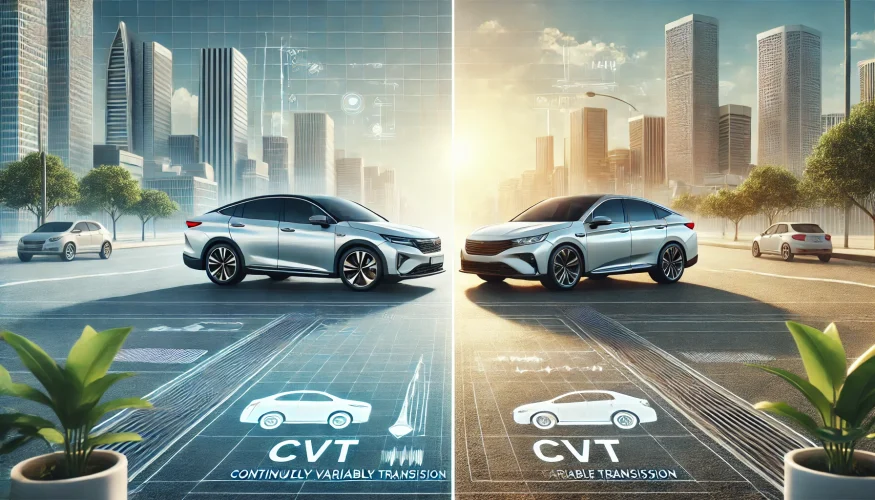
Cars with and without CVT: Understanding the Differences and Pros & Cons
When shopping for a car, one key factor that often goes unnoticed by many drivers is the type of transmission. In recent years, CVT (Continuously Variable Transmission) has become more common in cars, particularly in hybrids and fuel-efficient vehicles. However, traditional automatic and manual transmissions are still widely available. If you’re interested in exploring more options, check out the top cars without CVT transmission. Understanding the differences between cars with and without CVT can help you make a more informed decision when purchasing a vehicle.
A CVT, or Continuously Variable Transmission, is a type of automatic transmission that doesn’t have fixed gears like a conventional transmission. Instead, it uses a system of belts and pulleys to provide an infinite number of gear ratios. This allows the engine to run at its most efficient RPM (revolutions per minute), regardless of the vehicle’s speed.
The CVT operates by continuously adjusting the diameter of two pulleys connected by a belt. One pulley is connected to the engine, and the other is linked to the wheels. As the pulleys change their size, the transmission can seamlessly shift between gear ratios. The result is smoother acceleration and potentially better fuel efficiency because the engine can remain in its optimal power range.
1. Fuel Efficiency
One of the primary reasons automakers choose to equip cars with CVTs is the boost in fuel efficiency. CVTs allow engines to run at their most efficient RPM, reducing fuel consumption. This is particularly useful in hybrid vehicles, where maximizing fuel economy is a top priority.
2. Smoother Driving Experience
Unlike traditional automatic transmissions, which have noticeable gear shifts, a CVT offers a smoother driving experience. The transmission seamlessly adjusts the gear ratio, which means no abrupt gear changes. This can make acceleration feel more linear, especially in city driving.
3. Compact and Lightweight
CVTs tend to be smaller and lighter than traditional automatic transmissions. This contributes to the overall weight reduction of the vehicle, which in turn improves fuel efficiency. In vehicles where weight savings are crucial, such as compact cars and hybrids, this can be a significant advantage.
4. Quieter Operation
Because the CVT keeps the engine in its optimal range, the noise from the engine can be reduced, making for a quieter ride. This is especially noticeable during highway driving, where the engine noise is often more pronounced in vehicles with traditional transmissions.
1. Less Engaging Driving Experience
For some drivers, the seamless nature of a CVT can be a drawback. Without the distinct shifts of a traditional automatic or manual transmission, some enthusiasts feel that the driving experience is less engaging. The absence of gears can also make acceleration feel less responsive.
2. Durability Concerns
Historically, CVTs have had a reputation for being less durable than traditional automatic transmissions. Although modern CVTs have improved in reliability, they still tend to be more expensive to repair or replace. The complexity of the belt and pulley system can lead to issues over time, especially if the vehicle is driven aggressively or used for towing.
3. Cost of Maintenance
CVTs may require more frequent maintenance compared to traditional transmissions. Specialized fluid changes are essential to keep the transmission running smoothly, and neglecting these can lead to costly repairs. Additionally, not all mechanics are familiar with CVT systems, so maintenance can sometimes be more expensive.
Cars without CVT: The Alternatives
Vehicles without CVTs generally use one of two types of transmissions: traditional automatic transmissions or manual transmissions. Each offers its own set of advantages and disadvantages.
Traditional Automatic Transmission
A traditional automatic transmission uses a fixed number of gears to transmit power from the engine to the wheels. Most automatic cars have 6 to 10 gears, with modern versions offering smooth shifts and improved fuel efficiency compared to older models.
1. Advantages of Traditional Automatics
● Proven Reliability: Traditional automatics have been around for decades and are known for their durability and reliability.
● Responsive Acceleration: With fixed gears, automatic transmissions can provide more immediate acceleration, especially in high-performance cars.
● Widespread Availability: Parts and services for traditional automatics are readily available, making them easier and often cheaper to repair and maintain than CVTs.
2. Drawbacks of Traditional Automatics
● Less Efficient: Although modern automatics have become more fuel-efficient, they still can’t match the efficiency of CVTs in many cases.
● More Gear Shifts: Traditional automatics have noticeable shifts, which can feel less smooth compared to a CVT, particularly in lower gears.
Manual Transmission
Manual transmissions, or “stick shifts,” are becoming rarer in new cars but are still preferred by driving enthusiasts for the control they offer.
1. Advantages of Manual Transmissions
● Driver Control: A manual transmission gives the driver full control over gear selection, which many driving purists prefer.
● Simplicity and Reliability: Manual transmissions have fewer components than automatics, which often makes them more reliable and less expensive to repair.
● Engaging Driving Experience: For drivers who love to be engaged, the ability to control the gears and rev the engine to their preference provides a more exciting driving experience.
2. Drawbacks of Manual Transmissions
● Learning Curve: Learning to drive a manual car can be challenging for new drivers. It requires mastering the clutch and timing shifts properly.
● Inconvenient in Traffic: Constantly shifting gears in heavy traffic can be tiring and inconvenient, which is why manual transmissions are less popular in cities.
● Less Fuel-Efficient: While manuals were once considered more fuel-efficient than automatics, modern automatic transmissions and CVTs have surpassed them in this regard.
Cars with and without CVT: A Comparison
Fuel Efficiency
● With CVT: Superior fuel efficiency, particularly in stop-and-go city driving.
● Without CVT: Traditional automatics have improved, but manuals tend to lag behind modern automatics and CVTs in fuel economy.
Driving Experience
● With CVT: Smooth and quiet but less engaging for driving enthusiasts.
● Without CVT: More responsive and engaging, especially in manual cars, but shifts can feel jerky.
Durability and Maintenance
● With CVT: Can be expensive to repair and requires specialized maintenance.
● Without CVT: Traditional automatics are more reliable, while manual transmissions are the most durable and cheapest to maintain.
Conclusion: Which is Right for You?
The decision between cars with and without CVT ultimately comes down to your driving preferences and priorities. If fuel efficiency, a smooth driving experience, and low engine noise are at the top of your list, a car with a CVT might be the right choice. However, if you value durability, responsiveness, or a more engaging driving experience, a car with a traditional automatic or manual transmission could be more suitable.
Both types of transmissions have their pros and cons, so consider how and where you drive most frequently before making a decision.
The post Cars with and without CVT: Understanding the Differences and Pros & Cons appeared first on My Car Heaven.


